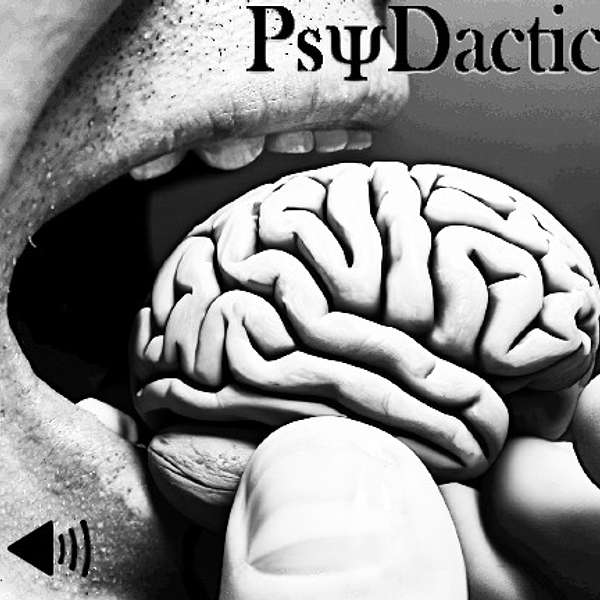
PsyDactic
A resource for psychiatrists and other medical or behavioral health professionals interested in exploring the neuroscientific basis of psychiatric disorders, psychopharmacology, neuromodulation, and other psychiatric interventions, as well as discussions of pseudoscience, Bayesian reasoning, ethics, the history of psychiatry, and human psychology in general.
This podcast is not medical advice. It strives to be science communication. Dr. O'Leary is a skeptical thinker who often questions what we think we know. He hopes to open more conversations about what we don't know we don't know.
Find transcripts with show-notes and references on each episodes dedicated page at psydactic.buzzsprout.com.
You can leave feedback at https://www.psydactic.com.
The visual companions, when available, can be found at https://youtube.com/@PsyDactic.
PsyDactic
Catatonic Signs - Echolalia, Echopraxia, and Agitation
Dr. O discusses the remaining hyperactive or “excited” signs of catatonia including echolalia, echopraxia, and agitation. In previous episodes, Dr. O discussed other hyperactive or “excited” signs, including mannerisms and stereotypy. All of these signs share the common feature that the patient is doing something odd, repetitive, or unexpected. Dr. O also gets on his soap box about the arbitrary use of the term agitation to describe patients.
Please leave feedback at https://www.psydactic.com or send any comments to feedback@psydactic.com.
References and readings (when available) are posted at the end of each episode transcript, located at psydactic.buzzsprout.com. All opinions expressed in this podcast are exclusively those of the person speaking and should not be confused with the opinions of anyone else. We reserve the right to be wrong. Nothing in this podcast should be treated as individual medical advice.
Welcome to PsyDactic Residency Edition. I am Dr. O and this episode is a continuation of our series on Signs of Catatonia. Today, I’ll discuss the remaining hyperactive or “excited” signs of catatonia including echolalia, echopraxia, and agitation. If you are encountering this episode without listening to the whole series on Catatonia, I suggest that you back up to episode 11 and start from there.
In previous episodes, I’ve discussed the hypoactive or “retarded” signs including stupor, mutism, negativism, grimacing, postering, and catalepsy, and other hyperactive or “excited” signs, including mannerisms and stereotypy. All of these hyperactive signs share the common feature that the patient is doing something odd, repetitive or unexpected. Let’s start this episode with the echophenomena.
In echopraxia, the patient repeats an action that the examiner performs without instructions to do so. This may seem similar to stereotypies which are performances of purposeless actions, but in stereotypes, the patient initiates the action without prompting. In echopraxia, the key is the echo. Praxia is from a Greek term meaning “to act.” Echopraxia is basically to act out something that you just saw someone else do. There seems to be an involuntary nature to the action, like it occurs automatically. There are some cool proposed neurological mechanisms that involve mirror neurons, communication between the occipital lobes and the inferior frontal cortex, supplementary and premotor cortices. There is a tendency for our brains to immediately plan out the action that we see other people doing, and this may help us understand the intended action’s meaning and predict what will happen next. Somehow, in echopraxia, there is either a lack of inhibition or an excess of excitation that results in the immediate performance of an action.
A paper (1) by Pridmore et al in 2008 in the Australian and New Zealand Journal of Psychiatry entitled “Echopraxia in schizophrenia: possible mechanisms” proposes that in echopraxia, there is some dysfunction in the mirror neuron system and its communication with the inferior frontal gyrus, premotor cortex, the anterior cingulate cortex, and the motor cortex. The normal inhibitory mechanisms break down, and observed actions are initiated automatically.
Testing for echopraxia in practice is a little more tricky than I originally imagined. Probably the most common way that practitioners test for echopraxia is by making an exaggerated movement to scratch their own head or rest their hand on their head and observe to see if the patient does the same. Often I go into a patient’s room and ask them to perform some action as a way to test their motor function. To help, I demonstrate what they are supposed to do. If I have, for example, just demonstrated an action to a patient and asked them to repeat it and then I do something else, like scratch my head and the patient does that too, I have confused the picture. I wouldn’t count that as clear echopraxia. There needs to be an unambiguous lack of prompting. Also, echopraxia that fulfills some useful social purpose is not pathological. If you wave back automatically after someone waves at you, this does not count as catatonia. If you cross your legs and the patient does the same, this is also not clearly echopraxia. But if you try uncrossing and crossing them again to see if the patient continues to repeat the action, and they do, then this is more likely pathological.
One part of the inferior frontal gyrus is Broca’s area, which helps you plan out the movements necessary to produce speech. Echolalia, then, could involve dysfunction in the same mirror neuron system as echopraxia, but instead of involving motor function of the torso and limbs, it involves motor function of the mouth and vocal chords. Echolalia is the most common of the echophenomena (2). Echolalia is also not necessarily pathological. It is pervasive among infants and toddlers and helps humans and non-human animals to learn language. It is also common among various psychiatric disorders, including autism spectrum disorders, Tourette’s, major neurocognitive disorders, after strokes or head injuries, in delirium, in some of the aphasias, after epileptic seizures, etc. Echolalia is built into human development and after the first couple years of life, we become experts at not simply repeating everything we hear (except in the case of my son, who incessantly repeats every curse I have ever uttered). Dysfunction in our ability to inhibit what appears to be the developmental default state of our brains likely plays a role in echolalia. Echolalia is also not necessarily immediate. If you say something to your patient like, “I’m Dr. O’Leary,” and then when you leave the room you hear them start to repeat, “I’m Dr. O’Leary,” this is also echolalia. The impression of your speech on their mind remained and is being repeated and imitated.
I have saved the best for last in my discussion of catatonia: Agitation. I have a guttural reaction to the word agitation. You might say, it agitates me. I have a personal vendetta against it, but I also find myself using it on almost a daily basis. The word “agitation” is used in such a wide variety of contexts to describe an almost infinitely broad set of actions in patients, that I almost want to make it a banned word in the medical record. If someone is a little irritated at having to wait 2 hours to be taken to the bathroom, they get described as being agitated. If they are throwing their furniture across the room, they get described as being agitated. If they decline medication, they get described as being agitated. Describing a patient as agitated also has an effect on how they are treated by physicians and nursing staff, so it is not a benign descriptor. Agitated patients are avoided, potentially neglected, frequently sedated, and sometimes physically restrained. When writing “agitation” as an indication for the heavy duty PRN medications we give, think twice about what you are doing, and maybe try to use other words like “violence or elopement” and make sure that catalonia is not high on your differential, because giving olanzapine, haloperidol or chlorpromazine to a catatonic patient is a mistake (3).
I know you don’t have time for my righteous indignation, so I am going to move on to what agitation means as a diagnostic sign in catatonia. Excited catatonia has also been called delirious mania and it is common in psychotic or manic patients. Agitation is one of the core features of excited catatonia, but in order to associate agitation clearly with catatonia, you need to establish a few things to differentiate it from other things that might cause agitation. What agitation is, by definition, is unclear. Catatonic agitation seems to be an increase in spontaneous, unprovoked motor activity that is internally motivated and that also appears in some degree to be involuntary or at least outside of the patient’s current ability to control. It may or may not seem to have a purpose, like trying to escape or evade capture. You don’t need to know exactly what is causing the patient to be agitated, but you need to rule out that it is a product of their environment, such as some noxious stimulus.
Psychosis and paranoid delusions can result in aggressive or violent, or recurrent agitation but imagine the case where you’ve started a patient on an antipsychotic and they seem to be getting worse, frequently attacking nurses, frantically pacing the halls, running at the entrance and throwing themselves like a flesh-missile at the doors. Or you have a manic patient, pacing the halls, jumping on the furniture and singing the national anthem. You give IM haloperidol, and they have paradoxical worsening of their behaviors. Worsening with antipsychotics is a reliable sign that the agitation is catatonic and not merely psychotic.
Because my brain likes to go to strange places, I am imagining the case where I am evaluating a patient whom I also suspect may be catatonic. I observe echolalia, what I believe is some negativism (they aren’t following my instructions), and apparent stereotypy (they are running around on tip toes, waving their hands) and agitation (they spontaneously attack another patient by punching them in the face). Do I diagnose catatonia? Or do I evaluate whether this patient has autism? Patients with autism spectrum disorder may also have catatonia, but a broad application of the signs of catatonia without a high prior probability that the condition exists can result in a false diagnosis despite technically meeting criteria. With this in mind, I want to introduce the next and last episode in this series on Catatonia, which will be a discussion of the Bush Francis Catatonia Rating Scale, which is probably the most commonly used diagnostic tool for diagnosis and rating the severity of catatonia that we have.
I am Dr. O, and this has been an episode of PsyDactic residency edition.
Bibliography
1. Pridmore S, Brüne M, Ahmadi J, Dale J. Echopraxia in schizophrenia: possible mechanisms. Aust N Z J Psychiatry. 2008;42(7):565-571. doi:10.1080/00048670802119747
2. Patra KP, De Jesus O. Echolalia. In: StatPearls. StatPearls Publishing; 2022.
3. Almeida M, Cicolello K, Hanso A, DeCavalcante G, DeOliveira GS. Treatment of acute agitation associated with excited catatonia using dexmedetomidine: case series and literature review. Prim Care Companion CNS Disord. 2021;23(5). doi:10.4088/PCC.20cr02899
Podcasts we love
Check out these other fine podcasts recommended by us, not an algorithm.

Mindhunting: Journeys in Forensic Psychiatry
Dr Michael Schirripa
Brain Science with Ginger Campbell, MD: Neuroscience for Everyone
Ginger Campbell, MD
